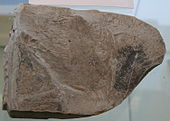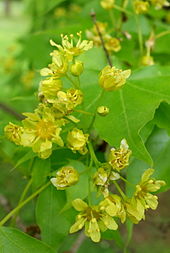Maples
| Maples | ||||||||||||
|---|---|---|---|---|---|---|---|---|---|---|---|---|

Sugar maple ( Acer saccharum ) |
||||||||||||
| Systematics | ||||||||||||
|
||||||||||||
| Scientific name | ||||||||||||
| Acer | ||||||||||||
| L. |
The maples ( Acer ) form a genus of plants in the subfamily of the horse chestnut family (Hippocastanoideae) within the soap tree family (Sapindaceae). There are 110 to 200 types of maple, depending on the author. They are widespread in temperate and tropical areas in Eurasia , North Africa , Central and North America . Many species are used in many ways.
Description and ecology


Appearance and leaves
Maple species grow as mostly deciduous or rarely evergreen trees or shrubs .
The constantly against arranged on the branches leaves are divided into petiole and leaf blade. The mostly simple leaf blade is mostly palmate. Some species have imparipinnate leaf blades with three or five leaflets , for example the ash maple ( Acer negundo ). There is a hand-shaped nerve. The leaf margin is smooth or serrated. There are no stipules . The foliage of many species has an intense autumn color.
Inflorescences and flowers
The flowers are clustered in umbrella or umbellate , rarely racemose or large panicle inflorescences .
The flowers are rarely hermaphroditic, but mostly functionally unisexual. The radial symmetry flowers are usually five-fold with a double flower envelope (perianth). There are usually five, rarely four or six sepals . There are usually five, rarely four or six petals , rarely missing. There are usually eight, rarely four, five, ten or twelve free stamens . Two carpels have grown together to form an upper ovary. There is rarely one, usually two ovules per carpel . The stylus is usually bifurcated and there are two scars. A distinction is made between insect and wind pollinated species. In insect-pollinated ( entomophilia ) species there is a disc at the base of the flowers because it is used to attract insects.
The floral formula is: .
Fruits and seeds
There are schizocarps formed, the winged than two Nuts ( Samara drop). Due to its special aerodynamic shape ( monopteros ), the fruit causes autorotation when falling , which causes the seeds to sink more slowly and the wind to distribute the diaspores over a large area .
There is no endosperm in the mature seed . The oil- or starch-containing embryo has an elongated radicle and two flat or folded green cotyledons ( cotyledons ).
Sets of chromosomes
The basic chromosome number is x = 13; there is mostly diploidy , i.e. 2n = 26.
Systematics and distribution
The genus name Acer was first published in 1753 by Carl von Linné in Species Plantarum . In 1913, Acer pseudoplatanus L. was established as the lectotype . Synonyms for Acer L. are: Argentacer Small , Negundo Boehm. ex Ludw. , Saccharodendron (Raf.) Nieuwl. , Rulac Adans. , Rufacer Small .
Molecular biological investigations showed that the genus Acer belongs to the subfamily Hippocastanoideae within the family Sapindaceae . It used to be part of the independent horse chestnut family (Hippocastanoiceae).
The genus Acer is widespread in the northern hemisphere in North Africa , Eurasia , Central and North America . Their species thrive in temperate , subtropical and tropical areas, but in the tropics only in the mountains. Many maple species have a Holarctic distribution. A large number of species are native to Asia and North America. 99 species occur in China , 61 of them only there. 13 species occur in Nepal and eight species in Pakistan .
Only a few maple species have been native to Europe since the Ice Ages . In the German-speaking area, there are Norway maple ( Acer platanoides ), sycamore maple ( Acer pseudoplatanus ) and field maple ( Acer campestre ) as well as French maple ( Acer monspessulanum ), snowball maple ( Acer opalus ) and Tatar steppe maple ( Acer tataricum ) wild.

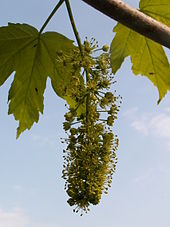


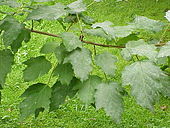
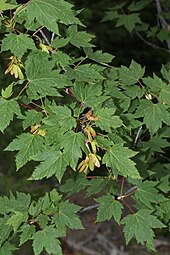
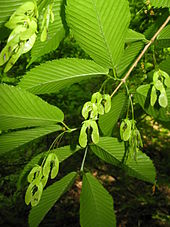
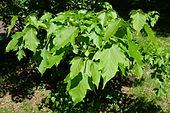

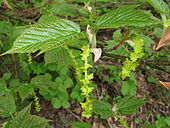

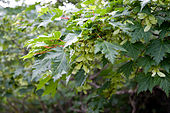





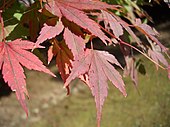

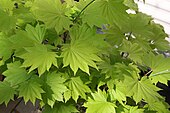
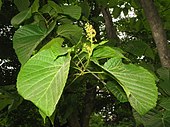
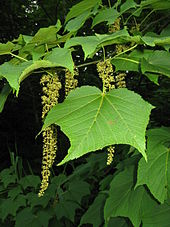

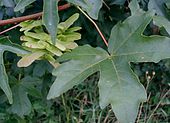


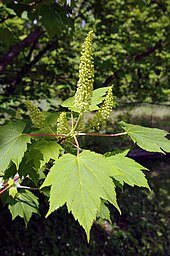

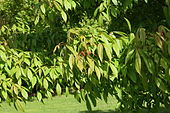
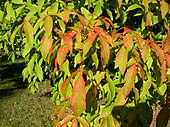
The genus maple ( Acer ) includes 110 to 200 species. The structure of the maple genus ( Acer ) is controversial, for example divided into the following sections (sect.), Some of which are even more finely divided into series (ser.):
- Section Acer Momotani : It contains about ten species in the northern hemisphere:
- Acer series :
- Acer cesium wall. ex Brandis (Syn .: Acer cesium subsp. giraldii (Pax) AEMurray , Acer giraldii Pax ): It thrives in the Hindu Kush and the Himalayas and is distributed from northern India , Pakistan and Nepal to China.
- Greek maple ( Acer heldreichii Orph. Ex Boiss. ): It is widespread in the southwest, southern, central and central-eastern Balkan Peninsula .
- Sycamore maple ( Acer pseudoplatanus L. ): It is widespread from Southwest, Central, North, East and Southeast Europe and in the Caucasus . He is a neophyte in many areas of the world .
- Caucasian maple ( Acer trautvetteri Medw. , Syn .: Acer heldreichii subsp. Trautvetteri (Medw.) AEMurray ): It is widespread in the Caucasus region and in Turkey .
- Velvet maple ( Acer velutinum Boiss. , Syn .: Acer insigne Boiss. & Buhse ): It occurs in Azerbaijan and Iran . It is used as an ornamental plant.
- Monspessulana series :
- Granada maple ( Acer granatense Boiss. , Syn .: Acer opalus subsp. Granatense (Boiss.) FQ & Rothm. , Acer opalus subsp. Hispanicum (Pourret) Murray , Acer hispanicum Pourret )
- Balkan maple ( Acer hyrcanum Fisch. & CAMey. ): It is widespread in Southeast Europe, West Asia , the Caucasus and the Crimea .
- French maple , castle maple ( Acer monspessulanum L. ): It is widespread in the Mediterranean area and is also found in Germany.
-
Snowball maple ( Acer opalus Mill. ): There are about two subspecies:
- Acer opalus subsp. obtusatum (Waldst. & Kit. ex Willd.) Gams (Syn .: Acer obtusatum Waldst. & Kit. ex Willd. , Acer opalus var. obtusatum (Waldst. & Kit. ex Willd.) Rchb. ): It comes in the northern Algeria , Albania , former Yugoslavia , Greece , Italy (including Sicily ) and Corsica .
- Acer opalus Mill. Subsp. opalus : It occurs in Germany (only small area), Switzerland (only small area), Italy , France (including Corsica ) and Spain .
- Crete maple ( Acer sempervirens L. , Syn .: Acer orientale auct.): It is mainly widespread in Greece in the Aegean region, there are individual occurrences in Turkey.
- Saccharodendron series :
- Sugar maple ( Acer saccharum Marshall ): It is widespread from Canada to the USA to Mexico and Guatemala . It is used as an ornamental plant. There are several subspecies depending on the author.
- Acer series :
- Section Arguta Rehder : It contains only four to five species in the Himalayas , China and Japan:
- Acer acuminatum Wall. ex D.Don : It is common in southern Tibet , northern India, Kashmir, Nepal and Pakistan.
- Fine-toothed maple ( Acer argutum Maxim. ): It occurs only on the Japanese islands of Honshū and Shikoku .
- Acer barbinerve Maxim. ex Miq. (Syn: Acer barbinerve var. Chanbaischanense S.L.Tung , Acer diabolicum subsp. Barbinerve (Maxim. Ex Miq.) Wesm. ): It occurs in eastern Russia, in North Korea and in the Chinese provinces of Heilongjiang , Jilin and Liaoning .
- Acer grandidentatum Nutt. : It was described from North America.
-
Acer stachyophyllum Here: There are two subspecies in northern India, in Bhutan, Myanmar, Nepal and in the Chinese provinces of southern Gansu , western Henan , western Hubei , Ningxia , southern Shaanxi , Sichuan, northwestern Yunnan and in southern and southeastern Tibet:
- Acer stachyophyllum subsp. betulifolium (Maxim.) PC de Jong
- Acer stachyophyllum Hiern subsp. stachyophyllum
- Section Ginnala Nakai : It contains only one species:
-
Tatar steppe maple ( Acer tataricum L. ): There are four subspecies:
- Fire maple or Amur maple ( Acer tataricum subsp. Ginnala (Maxim.) Wesmael ): It iswidespreadin China, eastern Russia, Mongolia , Korea and Japan .
- Acer tataricum subsp. semenovii (Regel & Herder) AEMurray : It is common in Southwest Asia , Afghanistan , southern Russia and western Xinjiang .
- Acer tataricum L. subsp. tataricum
- Acer tataricum subsp. theiferum (WPFang) YSChen & PC de Jong : It thrives in light forests below an altitude of 1,800 meters in the Chinese provinces of Anhui , northern Guangdong , Henan, Hubei, Jiangsu , Jiangxi , Shaanxi and Zhejiang .
-
Tatar steppe maple ( Acer tataricum L. ): There are four subspecies:
- Section Glabra Pax : It contains only one series:
- Glabra series :
- Bald maple ( Acer glabrum Torr. ): It is widespread in western to central North America. There are localities for the Canadian provinces of Alberta and British Columbia and the US states of Alaska , Washington, Montana , Oregon , Nebraska , Colorado, Wyoming , Nevada , Utah , California and New Mexico .
- Glabra series :
- Section Hyptiocarpa W.P.Fang : It contains only two species in Southeast Asia:
- Acer laurinum Hassk. (Syn .: Acer chionophyllum Merr. , Acer decandrum Merr. , Acer garrettii Craib , Acer laurinum subsp. Decandrum (Merr.) AEMurray , Acer longicarpum H.H. Hu & WCCheng , Acer macropterum T.Z.Hsu & H.Sun , Acer niveum Blume , Acer philippinum Merr. ): The wide distribution area of this relatively rare species extends into the southern hemisphere. It is distributed from southern India via Myanmar, Thailand , Cambodia , Laos , Vietnam , Malaysia to Indonesia , in the Philippines and in the Chinese provinces of southwestern Guangxi, Hainan, southeastern Tibet, northwestern and southern Yunnan.
- Acer pinnatinervium Merr. (Syn .: Acer jingdongense T.Z.Hsu , Acer machilifolium Hu & Cheng ): This very rare, endangered species occurs in northern India , Thailand, southwest Tibet and Yunnan.
- Section Indivisa Pax :
- Hornbeam-leaved maple ( Acer carpinifolium Siebold & Zucc. ): It thrives at altitudes of 200 to 1500 meters only on the Japanese islands of Honshū (western part), Shikoku and Kyushu.
- Section Lithocarpa Pax :
- Lithocarpa series : eight of the approximately nine Asian species occur in China, six of them only there:
- Acer diabolicum Blume ex K. Koch : It was described from Japan.
- Acer kungshanense W.P.Fang & CYChang (Syn .: Acer franchetii var. Acuminatilobum W.P.Fang & HFChow , Acer kungshanense var. Acuminatilobum (WPFang & HFChow) WPFang ): This endemic thrives in mixed forests in valleys at altitudes from 2000 to 3200 meters as well as southern Yunnan.
- Acer Leipoense W.P.Fang & TPSoong (Syn .: Acer Leipoense . Subsp leucotrichum W.P.Fang , Acer longipedicellatum C.Y.Wu ): This endangered endemic thrives in mixed forests at altitudes from 2,000 to 2,700 meters only in the southwestern Sichuan.
- Acer lungshengense W.P. Fang & LCHu (Syn .: Acer lichuanense C.D.Chu & GGTang ): It thrives in mixed forests in valleys at altitudes of 1500 to 1800 meters in the Chinese provinces of northeast Guangxi, southeast Guizhou, southwest Hubei and northwest Hunan.
- Acer sinopurpurascens W.C.Cheng : It thrives in mixed forests at altitudes of 700 to 1000 meters in the Chinese provinces of southern Anhui, northeastern Hubei, northern Jiangxi and northwestern Zhejiang.
- Acer sterculiaceum Wallich : It is common in northern India, Bhutan, southern Tibet and the Chinese provinces of Guizhou, southwestern Henan, northwestern Hubei, Hunan, southern Shaanxi, Sichuan and Yunnan.
- Acer thomsonii Miquel : It is distributed in northern India, Bhutan, Nepal, Myanmar, Thailand, southern Tibet and in the southern part of the Chinese province of Yunnan.
- Acer tsinglingense W.P. Fang & CCHsieh : It thrives in light forests at altitudes of 1200 to 1500 meters in the Chinese provinces of southeastern Gansu, southwestern Henan and Shaanxi.
- Acer yangbiense Y.S.Chen & QEYang : This rare and endangered endemic thrives in mixed forests in valleys at altitudes of around 2400 meters only in Yangbi in western Yunnan.
- Macrophylla Pojarkova series :
- Oregon maple ( Acer macrophyllum Pursh ): It is distributed in western North America from Alaska via British Columbia, Washington and Oregon to California.
- Lithocarpa series : eight of the approximately nine Asian species occur in China, six of them only there:
- Macrantha Pax section : It contains about 18 species in the Himalayas, China (eleven species), Taiwan (two species), Japan, eastern Russia and North America:
- Red snakeskin maple ( Acer capillipes Maxim. ): It occurs only on the Japanese islands of Honshu and Shikoku . It is used as an ornamental plant.
- Acer caudatifolium Hayata (Syn .: Acer kawakamii Koidzumi , Acer taiton-montanum Hayata ): It thrives in mixed forests at altitudes between 200 and 2100 meters only in Taiwan.
- Acer chienii Hu & WCCheng : It thrives in mixed forests at altitudes between 2200 and 3000 meters only in northwestern Yunnan.
- Hawthorn-leaved maple ( Acer crataegifolium Siebold & Zucc. ): It occurs only on the Japanese islands of Honshu, Kyushu and Shikoku. It is used as an ornamental plant.
- David's maple ( Acer davidii Franch. ): It is common in Myanmar and much of China. It is used as an ornamental plant.
- Acer forrestii Diels : It thrives in mixed forests in valleys at altitudes between 3000 and 3800 meters only in southwestern Sichuan and northwestern Yunnan. Some authors call it the subspecies Acer pectinatum Wall. ex G.Nicholson subsp. forrestii (Diels) AEMurray to Acer pectinatum .
- Acer komarovii Pojarkova : It occurs in northern Korea, eastern Russia and in the Chinese provinces of Jilin and Liaoning.
- Acer laxiflorum Pax : It thrives in mixed forests at altitudes of 1800 to 2500 meters only in Sichuan and Yunnan. Some authors call it the subspecies Acer pectinatum Wall. ex G.Nicholson subsp. laxiflorum (Pax) AE Murray to Acer pectinatum .
- Acer maximowiczii Pax (Syn .: Acer urophyllum Maxim. ): It thrives in mixed forests in valleys at altitudes between 1800 and 2500 meters in the Chinese provinces of southwestern Gansu, northeastern Guangxi, Guizhou, western Henan, western Hubei, Hunan, southwestern Qinghai, southwestern Shaanxi, southwestern Shanxi and Sichuan. Some authors call it the subspecies Acer pectinatum Wall. ex G. Nicholson subsp. maximowiczii (Pax) AE Murray to Acer pectinatum .
- Acer metcalfii Rehder : It thrives in mixed forests by rivers at altitudes of 800 to 1500 meters in northern Guangdong, northeastern Guangxi, southeastern Guizhou and southern Hunan.
- Small-flowered maple ( Acer micranthum Siebold & Zucc. ): It occurs only on the Japanese islands of Honshu, Kyushu and Shikoku.
- Acer morrisonense (Syn .: Acer rubescens Hayata ): It thrives in mixed forests at altitudes of 1800 to 2200 meters only in eastern and southern Taiwan.
- Acer pectinatum Wall. ex G.Nicholson nom. illegal. and nom. superfl. (A new valid name is required): It occurs from northeastern India via Bhutan, Nepal and northeastern Myanmar to China.
- Striped maple ( Acer pensylvanicum L. ): It is widespread in eastern to central North America. There are localities in the Canadian provinces of Nova Scotia , Ontario and Quebec and in the North American states of Minnesota , Wisconsin , Connecticut , Maine , Massachusetts , Michigan , New Hampshire , New Jersey , New York , Ohio , Pennsylvania , Rhode Island , Vermont , West Virginia , Georgia , Kentucky , Maryland , North Carolina , South Carolina , Tennessee , Virginia .
- Red-nerved snakeskin maple ( Acer rufinerve Siebold & Zucc. ): It occurs only on the Japanese islands of Honshu, Kyushu and Shikoku. It is used as an ornamental plant.
- Acer sikkimense Miq. (Syn .: Acer hookeri Miq. , Acer medogense T.Z.Hsu & ZKZhou , Acer pluridens T.Z.Hsu & H.Sun ): It occurs from Assam , Nepal, Sikkim , Bhutan via northern Myanmar and southeastern Tibet to Yunnan.
- Korean snakeskin maple ( Acer tegmentosum Maxim. ): It occurs in Siberia , Korea and in the Chinese provinces of Heilongjiang, Jilin and Liaoning.
- Acer tschonoskii Maxim. : It occurs on the Japanese islands of Hokkaidō , Honshu, Kyushu and Shikoku.
- Acer wardii W.W.Sm. (Syn .: Acer mirabile Handel-Mazzetti ): It occurs from north-east India via north-east Myanmar and east Tibet to north-west Yunnan.
- Section Negundo (Boehmer) Maxim. : It contains two series with a total of only three species in eastern Asia and North America:
- Cissifolia series :
- Cissus-leaved maple ( Acer cissifolium (Siebold & Zucc.) K.Koch ): It occurs on the Japanese islands of Hokkaidō, Honshū, Kyushu and Shikoku. It is used as an ornamental plant.
- Henry's maple ( Acer henryi Pax , Syn .: Acer cissifolium . Subsp henryi (Pax) AEMurray , Acer henryi var. Serratum Pamp. ): It thrives in mixed forests at altitudes of 500 to 1500 meters in the Chinese provinces of Anhui, Fujian, Gansu, Guizhou, Henan, Hubei, Hunan, Jiangsu, southern Shaanxi, southern Shanxi, Sichuan and Zhejiang.
- Negundo series
- Cissifolia series :
- Section Oblonga (Hu & WCCheng) Delendick : It contains about 15 species in the Himalayas, China (14 species), Laos, Thailand, Vietnam and Japan:
- Acer albopurpurascens Hayata (Syn .: Acer hypoleucum Hayata , Acer litseifolium Hayata ): It thrives in forests at altitudes of 400 to 2000 meters only in Taiwan.
- Tricorn maple , tricorn maple ( Acer buergerianum Miq. ): It is widespread in large parts of China, Taiwan and Japan.
- Acer cordatum Pax : The two varieties thrive in forests in valleys at altitudes of 200 to 1200 meters in the Chinese provinces of Anhui, Fujian, Guangdong, Guangxi, Guizhou, Hainan, Hubei, Hunan, Jiangxi, Sichuan, Yunnan and Zhejiang.
- Acer coriaceifolium Lev. (Syn .: Acer cinnamomifolium Hayata ): It thrives in forests at altitudes of 1500 to 2500 meters in the Chinese provinces of southern Anhui, Fujian, Guangdong, northern Guangxi, Guizhou, Hubei, Hunan, Jiangsu, Jiangxi, southeastern Sichuan and Zhejiang.
- Acer gracilifolium W.P. Fang & CCFu : It thrives in mixed forests near rivers at altitudes between 300 and 1000 meters only in southeastern Gansu and northern Sichuan.
- Acer lucidum F.P.Metcalf (Syn .: Acer laikuanii Y.Ling , Acer pehpeiense W.P.Fang & HYSu , Acer wuyishanicum W.P.Fang & CMTan ): It grows in forests at altitudes of 500 to 1000 meters in the Chinese provinces of Fujian, northern Guangdong, northern Guangxi, Jiangxi and Eastern Sichuan.
- Acer oblongum Wallich : The two varieties are distributed from northern India via Kashmir, Pakistan, Bhutan, Nepal, Laos, Myanmar, Thailand, large parts of China and Vietnam to southern Japan. It is used as an ornamental plant.
- Acer paihengii Hu & WCCheng : It thrives in laurel forests at altitudes of 700 to 1100 meters only in southeastern Yunnan.
- Acer paxii franch. : It thrives in mountain forests at altitudes of 1500 to 2500 meters in the Chinese provinces of central to northern Guangxi, Guizhou, southwestern Sichuan, northwestern Yunnan.
- Acer poliophyllum W.P. Fang & YTWu : It thrives in mixed forests at altitudes between 1000 and 1800 meters only in southwestern Guizhou and southeastern Yunnan.
- Acer shihweii F.Chun & WPFang : This very rare endemic thrives in dense forests at altitudes of around 1400 meters in Guizhou only in Pingba .
- Acer sycopseoides F.Chun : It thrives in forests at altitudes of 600 to 2100 meters only in northern Guangxi, southern Guizhou and central Yunnan.
- Acer yinkunii W.P.Fang : This rare species thrives in light forests at altitudes from 1000 to 2000 meters only in Guangxi.
- Acer yui W.P. Fang : It thrives in mixed forests at altitudes of 1800 to 2000 meters only in southern Gansu and northwestern Sichuan.
- Section Palmata Pax : It contains about 35 species. They are distributed from northern India via Bhutan, Nepal, Thailand, Myanmar China (34 species), Korea, Vietnam and Japan to southeastern Russia; they are also found in western North America. After a molecular genetic examination, there can be no breakdown into series:
- Acer calcaratum Gagnep. : It occurs in Myanmar, Thailand, Vietnam and southern Yunnan.
- Acer campbellii Hook. f. & Thomson ex Hiern : The two varieties are common in northern India, Bhutan, Myanmar, Nepal, Vietnam, southern Tibet, southern Sichuan and northwestern Yunnan.
- Acer ceriferum Rehder (Syn .: Acer anhweiense W.P. Fang & MYFang , Acer robustum Pax non Opiz ): It thrives in forests at altitudes of 700 to 2000 meters in the Chinese provinces of Anhui, southern Gansu, Henan, western Hubei, southern Shaanxi, Shanxi , Sichuan and Zhejiang.
- Acer chapaense Gagnep. : It occurs in Vietnam .
- Acer chingii Hu (Syn .: Acer sinense subsp. Chingii (Hu) AEMurray ): It thrives in forests at altitudes of 1200 to 2000 meters in the Chinese provinces of northern Guangxi and southern Guizhou.
- Vine leaf maple ( Acer circinatum Pursh ): It is distributed in western North America from the Canadian province of British Columbia via the US states of Washington and Oregon to California and is a neophyte in many areas of the world. It is used as an ornamental plant.
- Acer confertifolium Merrill & FPMetcalf (Syn .: Acer john-edwardianum F.P.Metcalf ): It thrives in mixed forests at altitudes of 500 to 1000 meters in the eastern Chinese provinces of Fujian, Guangdong northeastern, southeastern Jiangxi.
- Acer crassum Hu & WCCheng : This endemic thrives in mixed forests at altitudes of around 1000 meters only in southeastern Yunnan.
- Acer duplicatoserratum Hayata : It thrives in deciduous forests at altitudes of 200 to 2000 meters in Taiwan and distributed in the Chinese provinces of Anhui, Fujian, Guizhou, southern Henan, Hubei, Hunan, Jiangsu, Jiangxi, Shandong and Zhejiang. Since the distinguishing feature "downy hairs" shows transitions in the populations, it is not sufficient to differentiate between varieties.
- Acer elegantulum W.P. Fang & PLChiu (Syn .: Acer olivaceum W.P.Fang & PLChiu , Acer yaoshanicum W.P.Fang )
- Acer erianthum Heavy. (Syn .: Acer oxyodon Franch. Ex WPFang , Acer stachyanthum Franchet ex WPFang non Hiern ): It thrives in forests on mountains, but mostly in valleys at altitudes of 200 to 1400 meters in the Chinese provinces of southern Anhui, Fujian, Guangxi, Guizhou , Hunan, Jiangxi and Zhejiang.
- Acer fabri Hance (Syn .: Acer fargesii Veitch ex Rehder , Acer prainii H.Lév. ): It is widespread in Vietnam and in the Chinese provinces of Guangdong, Guangxi, Guizhou, Hainan, Hubei, Hunan, Jiangxi, Sichuan and Yunnan.
- Acer fenzelianum Handel-Mazzetti : It occurs in Vietnam and southern Yunnan.
- Acer flabellatum Rehder (Syn .: Acer gracile W.P.Fang & MYFang non Saporta , Acer mapienense W.P.Fang , Acer shangszeense W.P.Fang & TPSoong ): It is in Vietnam, Myanmar and in the Chinese provinces of Guangxi, Guizhou, western Hubei, Jiangxi, Sichuan as well as Yunnan spread.
- Acer hilaense Hu & WCCheng : This endemic thrives in mixed forests at altitudes of around 1500 meters only in western Yunnan.
- Japanese maple ( Acer japonicum Thunb. ): It occurs naturally in Japan and is planted in China, for example.
- Acer kuomeii W.P. Fang & MYFang : It thrives in mountain forests mostly in valleys at altitudes of 1300 to 2300 meters only in the Chinese provinces of western Guangxi and southeastern Yunnan.
- Acer kwangnanense Hu & WCCheng ( Acer fengii A.E. Murray ): This endemic thrives in mixed forests at altitudes of 1000 to 1500 meters only in southeastern Yunnan.
- Acer kweilinense W.P. Fang & MYFang (Syn .: Acer huangpingense T.Z.Hsu ): It thrives in light forests at altitudes of 1000 to 1500 meters only in the Chinese provinces of northeast Guangxi and southeast Guizhou.
- Acer laevigatum Wall. : The two varieties are common in northern India, Bhutan, Nepal, Myanmar, Vietnam, southern Tibet and the Chinese provinces of Guangdong, Guangxi, Guizhou, western Hubei, Hunan, northern Shaanxi, Sichuan and Yunnan.
- Acer linganense W.P. Fang & PLChiu : It thrives in mixed forests at altitudes of 600 to 1300 meters in the Chinese provinces of southern Anhui and Zhejiang.
- Acer miaoshanicum W.P.Fang : It thrives in mixed forests at altitudes of 900 to 1200 meters only in the northeastern Chinese provinces of Guangxi and southeastern Guizhou.
- Acer oligocarpum W.P. Fang & LCHu (Syn .: Acer foveolatum C.Y.Wu ): It thrives in mixed forests at altitudes of 1400 to 1600 meters in southern Tibet and in Yunnan.
- Oliver's maple ( Acer oliverianum Pax , Syn .: Acer lanpingense W.P.Fang & MYFang , Acer schneiderianum Pax & K.Hoffmann ): It thrives in forests in valleys at altitudes of 1000 to 2000 meters in central to northern Taiwan and in the Chinese provinces of Anhui , Fujian, southern Gansu, Guizhou, southern Henan, western Hubei, Hunan, Jiangxi, southern Shaanxi, Sichuan, Yunnan and Zhejiang.
- Acer osmastonii Gamble
- Japanese maple ( Acer palmatum Thunb. ): It is native to South Korea and the Japanese islands of Hokkaidō, Honshu, Kyushu and Shikoku. Many varieties are used as ornamental plants in temperate areas around the world. Some authors have subspecies, one of which is endemic to Honshu.
- Acer pauciflorum W.P.Fang (Syn .: Acer changhuaense (WPFang & MYFang) WPFang & PLChiu , Acer pubipalmatum W.P.Fang ): It thrives in light forests at altitudes of 500 to 1000 meters only in the Chinese provinces of southern Anhui and Zhejiang.
- Korean Japanese maple ( Acer pseudosieboldianum (Pax) Kom. ): It is found in eastern Russia, Korea and the Chinese provinces of Heilongjiang, southeastern Jilin and eastern Liaoning.
- Acer pubinerve Rehder : It thrives in forests at altitudes of about 100 meters in the Chinese provinces of southern Anhui, northern Fujian, Guangdong, northern Guangxi, southern Guizhou, eastern Jiangxi and Zhejiang.
- Acer pubipetiolatum Hu & WCCheng : The two varieties thrive in mixed forests, in valleys and on slopes of the tropical karst at altitudes of 800 to 2600 meters only in the Chinese provinces of southwest Guizhou and Yunnan.
- Acer serrulatum Hayata : It thrives in forests at altitudes of 1000 to 2000 meters only in central to northern Taiwan.
- Shirasawa's Japanese maple ( Acer shirasawanum Koidz. ): It occurs only on the Japanese islands of Honshu and Shikoku. It is used as an ornamental plant.
- Siebold's Japanese maple ( Acer Sieboldianum Miq. ): It is found on the Japanese islands of Hokkaidō , Kyushu , Honshū and Shikoku . It is used as an ornamental plant.
- Acer sinense Pax : It thrives in forests in valleys at altitudes of 500 to 2500 meters in the Chinese provinces of Fujian, Guangdong, Guangxi, Guizhou, Henan, Hubei and Sichuan.
- Acer sino-oblongum F.P. Metcalf : This endemic thrives in evergreen forests near the coast only in the Chinese province of Guangdong.
- Acer tonkinense Lecomte : It is common in Myanmar, Thailand, northern Vietnam, southeastern Tibet, and the Chinese provinces of Guangxi, southern Guizhou and southeastern Yunnan.
- Acer tutcheri Duthie : Of the two species, one is found only in Taiwan and the other is common in the Chinese provinces of Fujian, Guangdong, Guangxi, southern Hunan, southern Jiangxi and southern Zhejiang. They thrive in forests at altitudes of 300 to 1000 meters.
- Acer wangchii W.P.Fang : It thrives in mixed forests at altitudes from 700 to 1,500 meters just in the northern Chinese provinces of Guangxi and Guizhou.
- Acer wilsonii Rehder (Syn .: Acer angustilobum Hu , Acer sichourense (WPFang & MYFang) WPFang , Acer taipuense W.P.Fang ): It is Myanmar, Thailand, Vietnam, Tibet and in the Chinese provinces of northern Guangdong, northern Guangxi, Guizhou, Henan, Hubei, Hunan, Jiangsu, Jiangxi, southern Shaanxi, eastern Sichuan, Yunnan and Zhejiang are common.
- Section Parviflora Koidzumi :
- Series Distyla (Ogata) AEMurray :
- Acer distylum Siebold & Zucc. : It is endemic to Honshu .
- Parviflora series :
- Acer nipponicum H.Hara : It occurs on the Japanese islands of Honshū, Kyushu and Shikoku. It is used as an ornamental plant.
- Series Distyla (Ogata) AEMurray :
- Section Pentaphylla Hu & WCCheng : It contains only one series:
- Pentaphylla series : it contains only one species:
- Acer pentaphyllum Diels : This very rare, endangered species thrives in mixed forests in valleys at altitudes between 2300 and 2900 meters only in southwestern Sichuan.
- Pentaphylla series : it contains only one species:
- Section Platanoidea Pax : It contains 15 to 16 species in Europe, China (twelve species), Japan and Russia:
- Acer acutum W.P. Fang : It thrives in forests at altitudes between 800 and 1100 meters in southern Anhui, southern Henan, Jiangxi and Zhejiang.
- Acer amplum Rehder : It is common in Vietnam and the Chinese provinces of southern Anhui, Fujian, northwestern Guangdong, Guangxi, Guizhou, Hubei, Hunan, Jiangxi, Sichuan, Yunnan and Zhejiang.
- Field maple , also called Maßholder ( Acer campestre L. ): It is distributed from northwestern Africa across Europe to the Caucasus region to northern Iran Pakistan. It is planted in the temperate areas almost worldwide.
- Colchian maple ( Acer cappadocicum Gled. ): It occurs in southern Italy , in southwest Asia : northeastern Turkey, the Caucasus, northern Iran; Himalaya: in northern India, in Kashmir, Pakistan, Nepal, Bhutan, Tibet; Japan and the Chinese provinces of Guizhou, western Hubei, southern Shaanxi and Sichuan.
- Acer chunii W.P. catch : This rare species thrives in open forests at altitudes between 800 and 2500 meters in Fujian, northern Guangdong and southwestern Sichuan.
- Acer fulvescens Rehder : It thrives in forests at altitudes between 1800 and 3200 meters in Sichuan and southeastern Tibet.
- Acer longipes franch. ex Rehder (Syn .: Acer pashanicum W.P. Fang & TPSoong ): It thrives in mixed forests at altitudes between 300 and 1600 meters in the Chinese provinces of Chongqing, northern Guangxi, southern Henan, Hunan, western Hubei, Jiangxi and southern Shaanxi.
- Acer miaotaiense P.C.Tsoong (Syn .: Acer yangjuechi W.P.Fang & PLChiu ): It thrives in mixed forests at altitudes from 700 to 1,600 meters in the southeastern Chinese provinces of Gansu, southwestern Henan, northwestern Hubei, southern Shaanxi and Zhejiang.
- Miyabes maple ( Acer miyabei Maxim. , Sometimes a subspecies of Acer miaotaiense ): It is said to be found in Japan and China, but is synonymous in the Flora of China.
- Acer okamotoanum Nakai : In South Korea, this endemic occurs only in Kyongsang Puk.
- Acer pictum Thunb. ex Murray : It occurs with at least five subspecies in China, Japan, Korea, Mongolia and eastern Russia.
- Norway maple , also called pointed-leaved maple ( Acer platanoides L. ) It is widespread from Southwest, Central and North to East and Southeast Europe and in the Caucasus, West and Central Asia. There are sites from Spain , France , Belgium , Germany , Poland , the former Czechoslovakia and Austria to Hungary , in Switzerland , Italy , the former Yugoslavia , Bulgaria , Romania , Albania , Greece , Finland , Norway , Sweden , Estonia , Latvia , Lithuania , Belarus , the European part of Russia , Ukraine , Armenia , Azerbaijan , Georgia , Dagestan , Ciskaucasien, Kyrgyzstan , Tajikistan to Iran and Afghanistan .
- Acer shenkanense W.P.Fang ex CCFu (Syn .: Acer tricaudatum W.P.Fang & CCFu) : It thrives in forests along rivers, in mixed forests and in valleys at altitudes between 700 and 3000 meters in the Chinese provinces of southeastern Gansu, western Hubei, southern Shaanxi as well as northern to northwestern Sichuan.
- Acer tenellum Pax : It thrives in two varieties in mixed forests in valleys at altitudes between 1200 and 1900 meters in western Hubei and east to south-east Sichuan.
- Acer tibetense W.P. catch : It thrives in forests in valleys at altitudes between 1600 and 2700 meters only in southeastern Tibet.
- Chinese Norway maple ( Acer truncatum Bunge , Syn .: Acer lobulatum Nakai ): It is common in Korea and in the Chinese provinces of Gansu, Hebei, Henan, Jiangsu, Jilin, Liaoning, Nei Mongol, Shaanxi, Shandong and Shanxi.
- Section Pubescentia (Pojarkova) Ogata : It contains only two species in Pakistan, Afghanistan and northern China:
- Acer pilosum Maxim : It grows with two varieties in forests at altitudes between 1000 and 2000 meters in the Chinese provinces of Gansu, southwestern Nei Mongol, southeastern Ningxia, Shaanxi and Shanxi.
- Acer pentapomicum J.L. Stewart ex Brandis : It occurs in Pakistan and Afghanistan.
- Rubra Pax Section :
- Acer pycnanthum K. Koch : It is endemic to the Japanese island of Honshu.
- Red maple ( Acer rubrum L. , Syn .: Acer tomentosum Du Tour ): It is widespread in eastern North America. It is used as an ornamental plant.
- Silver maple ( Acer saccharinum L. ): It is common in eastern North America and is a neophyte in some areas of the world. It is used as an ornamental plant.
- Section Spicata Pax : Two of the three species occur in eastern and southern Asia and one in North America:
- Tailed maple ( Acer caudatum Wall. ): It is common in northern India, Bhutan, Nepal, Myanmar, southeastern Tibet and in the Chinese provinces of southeastern Gansu, western Henan, western Hubei, Ningxia, southern Shaanxi, western Sichuan and northwestern Yunnan.
- Vermont maple ( Acer spicatum Lam. ): It is common in North America.
- Acer ukurunduense Trautvetter & CAMeyer (Syn. Acer caudatum subsp. Ukurunduense (Trautv. & CAMey.) AEMurray , Acer caudatum var. Ukurunduense (Trautv. & CAMey.) Rehder , Acer dedyle Maxim. , Acer lasiocarpum H.Lév. & Vaniot , Acer spicatum var. ukurunduense (Trautv & Camey..) Maxim. , Acer spicatum var. ussuriense Budishchev , Acer ukurunduense var. changbaishanense W.Cao ): It is used in Japan, Korea, eastern Russia and the Chinese provinces of Heilongjiang, Jilin and Liaoning before.
- Section Trifoliata Pax : It contains two series with about five species in Eastern Asia:
- Grisea series :
- Cinnamon maple ( Acer griseum (Franch.) Pax , Syn .: Acer nikoense var. Griseum Franch. , Acer leiopodum (Handel-Mazzetti) WPFang & HFChow , Acer pedunculatum K.S.Hao , Acer shensiense W.P. Fang & LCHu , Acer triflorum subsp. leiopodum (Handel-Mazzetti) AEMurray , Acer triflorum var. leiopodum Handel-Mazzetti , Acer zhongtiaoense W.P. Fang & BLLi ): It thrives in mixed forests at altitudes between 1500 and 2000 meters in the Chinese provinces of southeastern Gansu, southwestern Henan, western Hubei, northwest Hunan, southern Shaanxi, southern Shanxi and eastern Sichuan.
- Nikko maple ( Acer maximowiczianum Miq. , Syn .: Acer nikoense hort. Non Maxim. , Acer maximowiczianum subsp. Megalocarpum (Rehder) AEMurray , Acer nikoense var. Megalocarpum Rehder , Negundo nikoense Miq. ): It occurs in China and Japan .
- Three-flowered maple ( Acer triflorum Kom. ): It occurs in Korea and in the Chinese provinces of Heilongjiang, Jilin and Liaoning.
- Mandshurica series :
- Manchurian maple ( Acer mandshuricum Maxim. , Syn .: Acer kansuense W.P.Fang & CYChang , Acer mandshuricum subsp. Kansuense (WPFang & CYChang) WPFang ): He comes in Korea south in eastern Russia and in the Chinese provinces of Gansu, Heilongjiang, Jilin , Liaoning and southern Shaanxi.
- Acer sutchuenense franch. : This very rare, endangered species thrives in mixed forests at altitudes between 1000 and 2500 meters in western Hubei, northwestern Hunan and Sichuan.
- Grisea series :
There are some hybrids (selection):
- Acer × boscii Spach
- Acer × coriaceum Bosc ex exchange (Syn .: Acer × rotundilobum Schwer. ) = Acer monspessulanum × Acer opalus
- Freeman's maple ( Acer × freemanii A.E. Murray = Acer rubrum × Acer saccharinum )
- Acer × hillieri Lancaster = Acer miyabei × Acer cappadocicum
- Acer × hybridum Bosc
- Acer × Schwerinii Pax
- Zoeschener maple ( Acer × zoeschense Pax ): This is a hybrid of field maple ( Acer campestre ) and Colchian maple ( Acer cappadocicum ).
confusion
Due to their similar leaf shapes, the maple-leaved plane tree ( Platanus × acerifolia ) , which is often planted as a street tree, is believed to be a maple species; However, in contrast to the maple species, plane tree species always have alternate leaves and often a very characteristic bark.
use
Wood
Maple wood is mainly used as furniture wood. The wood of some tall species such as the sycamore maple ( Acer pseudoplatanus ) and the Norway maple ( Acer platanoides ) in Eurasia is of particular commercial relevance . In North America, the sugar maple ( Acer saccharum ) and the black sugar maple ( Acer saccharum subsp. Nigrum ) as "American hard maple" as well as the red maple ( Acer rubrum ) and the silver maple ( Acer saccharinum ) important as an American soft maple. The Japanese maple ( Acer pictum ) plays a central role in the East Asian region. Other species such as the field maple ( Acer campestre ) are of subordinate or regional importance.
The wood of the sycamore maple ( Acer pseudoplatanus ) is one of the valuable hardwoods. Yellowish-white to white in color, the annual rings are recognizable, but the sapwood and core are not separated from each other, but are of the same color. The medium-weight, elastic, tough, hard wood only shrinks slightly. The flexural strength is good. The wood is not very weatherproof. The surfaces are easy to work on, easy to polish, stain and color. Treatment with varnishes is also problem-free.
Particularly in the 1950s and in the first half of the 1960s, both plain and figured (flamed maple ) maple veneers were very popular for bedroom furniture, solid for drawers and for small pieces of furniture. It was also often used as a contrasting wood in the form of edges and decorative strips. Due to its tendency to yellow relatively quickly, it was not used for exterior fronts in furniture construction. Today it is still used for the interior lining of high quality furniture. Maple wood is used by cabinet makers to manufacture the finest furniture, and it is also used for inlay work (inlay work). A special type of use of maple are unpainted table tops for pub tables made from solid wood. Parquet made from American hard maple is considered to be particularly valuable and is characterized by high wear resistance. It is also well suited for building stairs.
Selected sycamore maple has long been used as decorative and resonance wood for the manufacture of musical instruments (string, plucked and wind instruments, drum kettles). Back, sides and necks made of maple are the norm for classical string instruments . Especially popular here's maple in veneered parts and birdseye maple . Turners, carvers and sculptors like to use maple wood for their work, as fine details can be worked out here. The fine-pored wood is also used for sports, play and kitchen equipment. Strong branches and crooked trunks are used as industrial wood in the chipboard industry or are in great demand as firewood.
Maple syrup
Maple syrup is made from the sap of the sugar maple ( Acer saccharum ) native to North America . This is made by boiling down the tree sap that emerges from the trunk after tapping. Sugar can also be extracted from the silver maple ( Acer saccharinum ).
Maple seedlings
The maple seedlings that sprout around the plant in the ground foliage from mid-February to early April are collected before they become seedlings and are suitable for raw consumption. The fresh sprouts have a tart, strong taste and are rich in ingredients. It must be noted, however, that maple seedlings of some species contain a toxin with hypoglycine .
Ornamental plants
Many varieties of different types of maple are used as ornamental plants for gardens, parks and avenues . You can also work the maple as a bonsai . There is a multitude of variegated to spherical varieties.
Others
The disease of animals known as "red maple toxicosis" after eating the withered leaves of the red maple ( Acer rubrum ) is significant from a veterinary perspective .
According to recent findings by the in sycamore seeds and -keimlingen contained hypoglycin a mostly fatal atypical Weidemyopathie triggered the horse.
Cultural history
According to popular superstition, the maple offers effective protection against witches. In Western Pomerania, for example, the doors and rooms were decorated with maple, in Mecklenburg the witches were to be kept away from stables by driving maple tenons into the doors and thresholds. The same effect should be achieved if maple branches were pinned to doors and windows on June 24th . This ritual should also protect against lightning strikes. To protect against moles, potato and flax fields were surrounded by maple branches in Revensburg. It is known from Alsace that maple branches on doors should keep bats away from the house.
In folk medicine, the maple leaves picked on June 24th are dried and softened in boiling water. They are considered curative for all wounds.
In Upper Bavaria it was believed that fat maple leaves indicated a good, productive harvest. Furthermore, watering the roots with wine has been handed down - this should make a wish come true.
The sycamore maple of Trun in the canton of Graubünden is famous . Under him on May 16, 1424 the upper or gray covenant was sworn. In 1750 the tree had a total circumference of 16 meters. In 1824 two of the three tribes were still standing. When the almost 500-year-old maple was knocked over by a storm in 1870, a young sycamore maple was planted from a seed of the old one, which is still there today. In 1890, the root of the old tree was ceremoniously transferred to the conference room of the great union and is now in the Sursilvan Museum in Trun . The maple is also often used in place and field names. In Upper Valais, “Agarn” and “Ayer” in the French region correspond to “Ahorn”.
symbolism
The maple leaf is a symbol of Canada and is used in the Canadian flag since 1965 to represent the country's vast forests. The model probably came from the sugar maple ( Acer saccharum ). In China , the maple is a symbol of office.
literature
- Tingzhi Xu, Yousheng Chen, Piet C. de Jong, Herman John Oterdoom, Chin-Sung Chang: Aceraceae. In: Wu Zheng-yi, Peter H. Raven, Deyuan Hong (Eds.): Flora of China . Volume 11: Oxalidaceae through Aceraceae . Science Press / Missouri Botanical Garden Press, Beijing / St. Louis 2008, ISBN 978-1-930723-73-3 , Acer , p. 516 (English, online ). (Sections Description and Systematics)
- Helmut Pirc: Maples . Eugen Ulmer, Stuttgart (Hohenheim) 1994, ISBN 3-8001-6554-6 .
- D. Grosser, W. Teetz: Maple . In: Local timber (loose-leaf collection) . Information Service Holz, Holzabsatzfonds - Sales promotion fund of the German forest and wood industry, 1998, ISSN 0446-2114 .
- Paul Wagler : Maple . In: Paulys Realencyclopadie der classischen Antiquity Science (RE). Volume I, 1, Stuttgart 1893, Col. 917-919.
- Shing-Fan Huang, Robert E. Ricklefs, Peter H. Raven: Phylogeny and Historical Biogeography of Acer I - Study History of the Infrageneric Classification. In: Taiwania , Volume 47, Issue 3, 2002, pp. 203-218. doi : 10.6165 / tai.2002.47 (3) .203
- Jianhua Li, Jipei Yue, Suzanne Shoup: Phylogenetics of Acer (Aceroideae, Sapindaceae) based on nucleotide sequences of two chloroplast noncoding regions. In: Harvard Papers in Botany , Volume 11, Issue 1, 2006, pp. 101-115. doi : 10.3100 / 1043-4534 (2006) 11 [101: POAASB] 2.0.CO; 2
- Guido W. Grimm, Susanne S. Renner , Alexandros Stamatakis, Vera Hemleben: A nuclear ribosomal DNA phylogeny of acer inferred with maximum likelihood, splits graphs, and motif analysis of 606 sequences. In: Evolutionary bioinformatics online. Volume 2, 2006, pp. 7-22, PMID 19455198 , PMC 2674679 (free full text).
Individual evidence
- ↑ a b c d e f g h i j k l m n o p q r s t u v w x y z aa ab ac ad ae af ag ah ai aj ak al am an ao ap aq ar as at au av aw ax ay az ba bb bc bd be bf bg bh bi bj bk bl bm bn bo bp bq br bs bt bu bv bw bx by bz ca cb cc cd ce cf cg ch ci cj ck cl cm cn co cp cq cr cs ct cu cv cw cx cy cz da db dc dd Tingzhi Xu, Yousheng Chen, Piet C. de Jong, Herman John Oterdoom, Chin-Sung Chang: Aceraceae. In: Wu Zheng-yi, Peter H. Raven, Deyuan Hong (Eds.): Flora of China . Volume 11: Oxalidaceae through Aceraceae . Science Press / Missouri Botanical Garden Press, Beijing / St. Louis 2008, ISBN 978-1-930723-73-3 , Acer , p. 516 (English, online ).
- ↑ Carl von Linné: Species Plantarum. Volume 2, Lars Salvius, Stockholm 1753, p. 1054 ( digitized ).
- ^ Acer at Tropicos.org. Missouri Botanical Garden, St. Louis
- ↑ a b c d e f g h i j k l m n o p q r s t u v w x y z aa ab ac ad ae af ag ah ai aj ak al am Acer in the Germplasm Resources Information Network (GRIN), USDA , ARS , National Genetic Resources Program. National Germplasm Resources Laboratory, Beltsville, Maryland. Retrieved June 8, 2017.
- ↑ Diethard H. Storch, Helmut Prier: Exotic trees in the KIRCHHEIMER-Arboretum Freiburg (= information 15 of the State Office for Geology, Raw Materials and Mining Baden-Württemberg ). P. 13, (PDF file; 1.4 MB).
- ^ John Robert Press, KK Shrestha, DA Sutton: Annotated Checklist of the Flowering Plants of Nepal. The Natural History Museum, London 2000, ISBN 0-565-09154-9 , updated version on efloras.org .
- ^ A b c d e Edward Murray: Flora of West Pakistan 92: Aceraceae. Stewart Herbarium, Gordon College (inter alia), Rawalpindi 1975, p. 1, online with the same text as the printed work Acer at Tropicos.org. In: Flora of Pakistan . Missouri Botanical Garden, St. Louis.
- ↑ Jianhua Li: Phylogenetic Evaluation of Series Delimitations in Section Palmata (Acer, Aceroideae, Sapindaceae) Based on Sequences of Nuclear and Chloroplast Genes. In: Aliso. Volume 29, No. 1, 2011, pp. 43-49, DOI: 10.5642 / aliso.20112901.05 .
- ↑ Chin-Sung Chang, Kwang-Bok Woo: A New Taxonomic Treatment for the Acer duplicatoserratum Complex (Aceraceae) in China and Taiwan. In: Journal of Japanese Botany , Volume 86, 2011, pp. 219-224. Full text PDF.
- ↑ Delicacies from forest trees , Markus Strauss, Hädecke Verlag (2014).
- ^ Uwe Lochstampfer: Poison Plants. In: botanikus.de. Retrieved January 3, 2019 .
- ↑ Landesarboretum database - University of Hohenheim . ( Memento from May 24, 2011 in the Internet Archive )
- ↑ Voiton DM: The cause of atypical myopathy has been discovered - what should we do now? In: Vetline.de, quoted from Pferdeheilkd 31 (6): 571-577. March 24, 2016, accessed August 13, 2018 .
Web links
- Maples - the "sugar trees" ( Memento from November 24, 2012 in the Internet Archive ) - Contribution from LWF-aktuell 62 of the LWF
- Material archive: Ahorn - extensive material information and pictures





